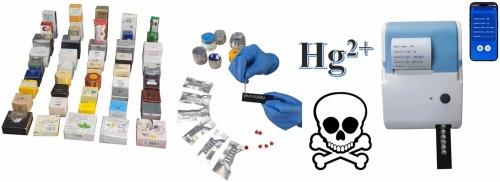基于硫脲-希夫碱的便携式正面荧光传感平台,用于快速,现场检测美白化妆品中的有害汞污染
IF 11.3
1区 环境科学与生态学
Q1 ENGINEERING, ENVIRONMENTAL
引用次数: 0
摘要
开发不经任何预处理直接检测实际样品中的汞(Hg2+)的方法仍然是分析化学中的重大挑战。在本研究中,我们开发了一种便携式正面荧光系统(PFFFS),这是一种简单、快速、高度实用的方法,只需要将样品与预先制备的试剂盒混合即可立即检测,无需样品预处理、称重或消化,可在美白化妆品中进行Hg2+的现场检测。我们系统地研究了pH、反应时间、干扰离子掩蔽剂和荧光探针稳定剂对Hg2+测定的影响。为了减轻Hg2+污染引起的记忆效应,设计了一次性一次性试剂和耗材。利用PFFFS中实际Hg2+含量(ICP-MS测量)与荧光强度之间的相关性,有效降低了基质干扰。在最佳条件下,该方法的检出限为6.8 mg/kg,线性范围为23.2 ~ 4429 mg/kg。该方法成功地应用于216种美白化妆品(包括各种面霜、乳液和香精乳液)中Hg2+的检测,结果与ICP-MS分析结果一致。与传统分析技术相比,PFFFS方法具有成本更低、检测时间更短(6分钟)、便携性和适合消费者自检等明显优势。这种PFFFS方法可以在常规实验室检测之前作为高Hg2+污染的早期预警工具,保护敏感的实验室仪器,并通过快速现场筛选潜在危险化妆品来提高消费者安全。此外,通过促进及时检测和控制Hg2+暴露,该方法有助于减少环境污染和相关的人类健康风险。本文章由计算机程序翻译,如有差异,请以英文原文为准。

A portable front-face fluorescence-sensing platform based on thiourea-Schiff-base for rapid, on-site detection of hazardous mercury contamination in whitening cosmetics
Developing methods for directly detecting mercury (Hg2+) in real samples without any pretreatment remains a significant challenge in analytical chemistry. In this study, we developed a portable front-face fluorescence system (PFFFS), a simple, rapid, and highly practical method that requires only the mixing of the sample with the pre-prepared reagent kit for immediate testing, requiring no sample pretreatment, weighing, or digestion, enabling on-site Hg2+ detection in whitening cosmetics. We systematically investigated the effects of pH, reaction time, interfering ion masking agents, and fluorescent probe stabilizers on the measurement of Hg2+. To mitigate memory effects caused by Hg2+ contamination, single-use disposable reagents and consumables were designed. The correlation between actual Hg2+ content (measured by ICP-MS) and fluorescence intensity obtained from PFFFS was utilized to effectively reduce matrix interference. Under optimal conditions, the method had a detection limit of 6.8 mg/kg and a linear range of 23.2-4429 mg/kg. The proposed method was successfully applied to detect Hg2+ in 216 whitening cosmetics, including various creams, lotions, and essences lotion, with results consistent with those obtained from ICP-MS analyses. Compared with conventional analytical techniques, the PFFFS method offers distinct advantages such as lower cost, shorter detection time (6 min), portability, and suitability for consumer self-testing. This PFFFS approach can serve as an early warning tool for high Hg2+ contamination before routine laboratory testing, protect sensitive laboratory instruments, and enhance consumer safety by enabling rapid on-site screening of potentially hazardous cosmetics. Furthermore, by facilitating timely detection and control of Hg2+ exposure, this method contributes to reducing environmental contamination and associated human health risks.
求助全文
通过发布文献求助,成功后即可免费获取论文全文。
去求助
来源期刊

Journal of Hazardous Materials
工程技术-工程:环境
CiteScore
25.40
自引率
5.90%
发文量
3059
审稿时长
58 days
期刊介绍:
The Journal of Hazardous Materials serves as a global platform for promoting cutting-edge research in the field of Environmental Science and Engineering. Our publication features a wide range of articles, including full-length research papers, review articles, and perspectives, with the aim of enhancing our understanding of the dangers and risks associated with various materials concerning public health and the environment. It is important to note that the term "environmental contaminants" refers specifically to substances that pose hazardous effects through contamination, while excluding those that do not have such impacts on the environment or human health. Moreover, we emphasize the distinction between wastes and hazardous materials in order to provide further clarity on the scope of the journal. We have a keen interest in exploring specific compounds and microbial agents that have adverse effects on the environment.
 求助内容:
求助内容: 应助结果提醒方式:
应助结果提醒方式:


